LD Systems Maui 5—compact line array and integrated mixer—test report by tools4music
Active column PAs have firmly established themselves in the audio industry. The systems impress with their convenient transportation options, quick set up and unobtrusive appearance compared to classic speaker boxes. The range of systems available is expanding constantly—and one of these is the “MAUI” series from LD Systems. The newcomer is called simply “MAUI 5” which—to blow the secret behind the name—houses five speakers.

The development team at Adam Hall Group (LD systems is a house brand) located in Neu-Anspach, Hesse, set the most recent addition to the “MAUI” family some pretty stiff standards: light weight, best possible sound for its size and modern transmission/reception technology such as Bluetooth had to find their way into the “MAUI 5”. Including light handling and convenient transportation.
The result: Weighing in at little more than 11kg, the “MAUI 5” is an ultra-compact PA and monitor system that, according to the manufacturer, delivers 800 watts peak power and can generate a sound pressure of 120 dB. The four components made of ABS plastic are set up in a matter of seconds. Three short columns (approximately 3 kg in total) are also placed on the subwoofer. Specially developed multi-pin connectors provide support for simultaneous transmission of signals because a connecting cable from the subwoofer to the column is not required in this system either.
The electronics and a 4-channel mixer with DSP and Bluetooth are integrated into the 305 x 405 x 395 mm (W x H x D) large subwoofer. The bass-reflex enclosure (weight 8.3 kg) is home to not only the 8-inch subwoofer. The fan-less, class-D power amp with various protection circuits, as well as the so-called LECC signal processing with compressor, limiter, equalizer and crossover are also accommodated. Two of the three plug-in column systems serve only as spacers, making them a visually appropriate substitute for a distance steel rod. They only transfer the audio signals to the final element, which limits the column upwards. In this upper element are four 3-inch speakers with neodymium magnets to save weight.
The only column element with speakers can also only be used with one adapter, making the system appear visually smaller (alternative for presentations or when working with platforms). Once all the elements are installed, the height is almost two metres (1,985 mm).
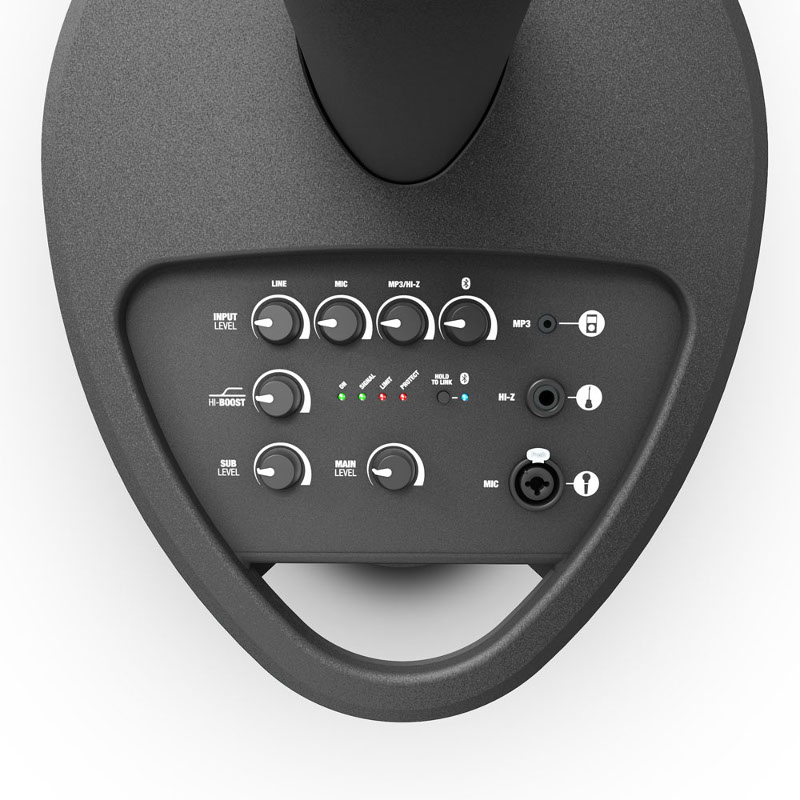
The “MAUi 5” has departed from the somewhat angular incarnation of the previous “MAUI” design. The look is rounder, smoother and at least for my taste more elegant. Despite the relatively small bass speaker, playback of above 50 Hz should be possible whereby physics will certainly prevent a thunderstorm of bass. Above this, the frequency range ends at 20 kHz. Dedicated to producing smooth playback in the low-frequency is range the LECC signal processing, which adjusts the bass reproduction according to volume and which, with an optimized compressor / limiter switch, is designed to allow high volumes without sounding stressful. The beam angle is stated by LD systems as 120°x20° (horizontal x vertical), so a wide spread in the horizontal and low spread in the vertical. This is after all one of the benefits of this system design—although again, simply due to the laws of physics, the short length means necessary shortcuts in comparison with “full-size line arrays”.
Subwoofer
Let’s take a closer look at the heart of the matter, the subwoofer. The teardrop-shaped enclosure (when viewed from above) can be easily carried via the visually integrated handle with rubberized surface. Also, the handle’s design protects the recessed back panel. This is also where the connections (locking combo jacks) are for line signals left and right, such as for the outputs of an external mixer. The woofer and bass reflex port sit behind the protective grille with its acoustic foam.
They are both completely hidden, and the front protector is not easy to remove, which is why I leave my screwdriver set in the drawer for the time being. The four-channel mixer is fitted so that it is accessible from above.
There is a locking combo input for microphones (without phantom power) with fixed 100-Hz low-cut, a high-impedance Hi-Z 6.3mm jack input for acoustic or electric guitar and a 3.5mm mini jack (stereo) for MP3 players, smartphones and other stereo players.
Stereo signals are, incidentally, combined. This also applies to rear panel line inputs (mono operation via the left input). Controllers are available for line, mic, MP3 / Hi-Z and Bluetooth transmission. The MP3 and Hi-Z inputs can be used in parallel; the volume in this case is controlled with the playback device or on the guitar. You can enable the Hi-shelf filtering (shelving) to suit room acoustics with Hi-boost. Turning clockwise raises the height continuously. The relationship between the subwoofer and column is controlled via the sub-level potentiometer and so sets the desired level of bass. The total volume is adjusted via the main controller. And four control LEDs provide information about the on, signal, limit and protect statuses.
Bluetooth is connected via a button which I had to press for quite a long time the first time (about five seconds) until I finally got the connection. The apt-X codec for optimized audio transfer is not used. The surface of the mixer is practically designed, with clearly visible white markings that can be easily read even in dark environments. The haptic effect of the easy-locking dial and rubberized potentiometer buttons is good.
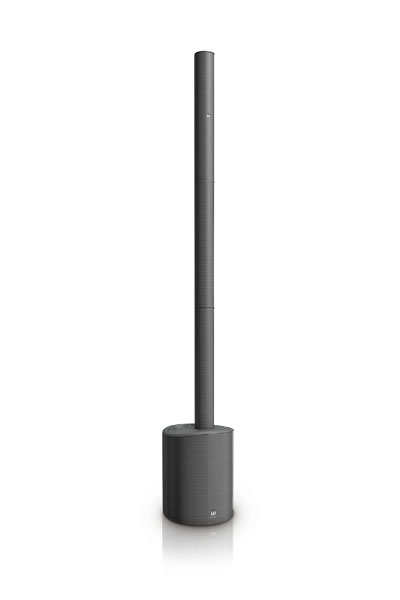
Plug-in system
The interesting aspect of the 57-cm-long and pluggable column elements is the plug-in mechanism design. First of all, nothing can go wrong during assembly; secondly, this enables elements to be held together safely. The connection of the entire column to the subwoofer looks very stable, although this is made of plastic parts, here used as connecting elements. This is one difference to the previous MAUIs, which used aluminium columns and for which finger-width steel pins made the connections.
So what does the top column with the four speakers contain? Well, this time I do have to get my screwdriver set. Undoing the top closure doesn’t reveal much, with our photo just giving us a surface look. What we can see on top is a roundish-shaped grille with the thick layer of acoustic foam. On the plastic baffle one of the four 3-inch drivers is visible, and behind it, so to speak in the slim speaker housing, is the damping material. The pretty concise operating manual mentions four tweeters/ mid-range drivers with neodymium magnets. The design of the pillar elements strictly mirrors that of the subwoofer, thus giving the all-round look an elegant touch.
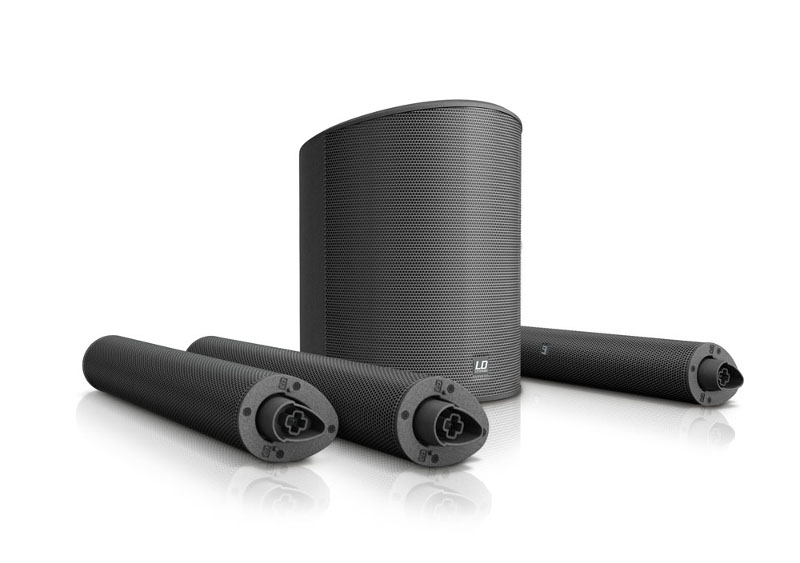
Sound
Typical for the current market, this complex system is ready for immediate use: snap the elements together, connect the mains cable, ready to go. In the first sound test, the sound produced from various music genres gets the thumbs up. The Bluetooth connection allows the music to be transferred smoothly, and customized via an integrated mixer (keyword here: karaoke).
Next to be hooked up are a Shure SM-58 as well as my Fender “Strat”. Both classics in their fields which I like to use for testing. Once the Hi-shelf system is turned up fully, I don’t want to touch the tone controls again—the sound is now so much more open. The fully engaged treble control sees the “Strat” come through really well too. The preferred position between bridge and middle PU now produces a real pearl of a sound. I must emphasize here that the “MAUI 5” is of course not a guitar amplifier. But the HiZ input does a good job, which I notice later with my electric-acoustic Yamaha. What I do notice is the following: near to the system, i.e. at close range, the sound doesn’t flow together when using a microphone at low volume.
What you can hear is the split to the upper part of the column, where the drivers have been positioned. Not to be forgotten however is that the distance at full height between bass speaker and the top part is a good 1.4 m. This effect wasn’t so pronounced in the test when playing CDs loudly. Here, the heavier bass tones enabled a homogeneous sound flow. My test basically confirmed that maintaining a certain distance to the “MAUI 5′ brings benefits. But to counteract this effect, it is worth simply trying to omit one of the distance column elements in order to reduce the length of the column. This can be advantageous at close range or if the system is positioned on a table or podium for example.
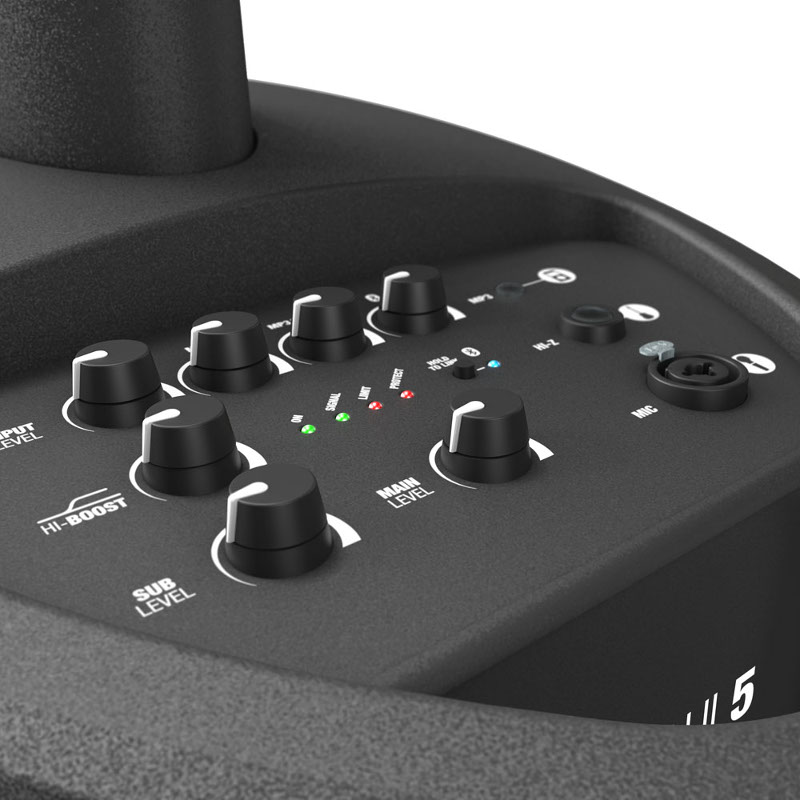
Measurement
A woofer and four relatively small mid-range speakers that also operate at considerable distance from the bass speaker—how does the sound of the mids perform? I check this out with the phonic PM-3 analyzer and some pink noise.
Rather than do the test under clinical conditions in an echo-free room or in the open, I chose an ordinary environment where the “MAUI 5” can be heard normally. I set the distance between the test microphone and the system at around 4 m, aligned to the centre of the system. I turned the HiBoost, in this case, right up to the stop, with the bass control centred. The result surprised me: even at different volumes there is no pronounced central hole.
Live
A performance by acoustic duo RosenRot with two vocals and acoustic guitar saw the “MAUI 5” pass this live test under real conditions. The balanced outputs of the external small mixer fed directly into both inputs of the “MAUi”. Placed slightly to the side of the two musicians, the pillar system projected out into a cafe with about 60 guests for around two hours. In its recommendations for the “MAUI 5′ in mono mode for live performance, LD systems states a figure of 100 listeners (background music mode) or 50 listeners (party music mode) for sound projected over a space of about 200 square metres. The test environment is thus excellent since the size of the performance location matches up pretty closely.
Because the acoustic guitar is the sole accompanying instrument in the performance, the subwoofer is not specifically required. Also in the live test the already mentioned sound-setting remains the same—the bass control is in central position, the treble with shelving characteristic turned almost right up. The sound comes through and reproduces the duo’s vocals, the volume is more than sufficient and there’s even some power left over. After two sets and a little over two hours of playing music from right across the genres, the duo happily receive the positive feedback—especially on the system’s overall performance.
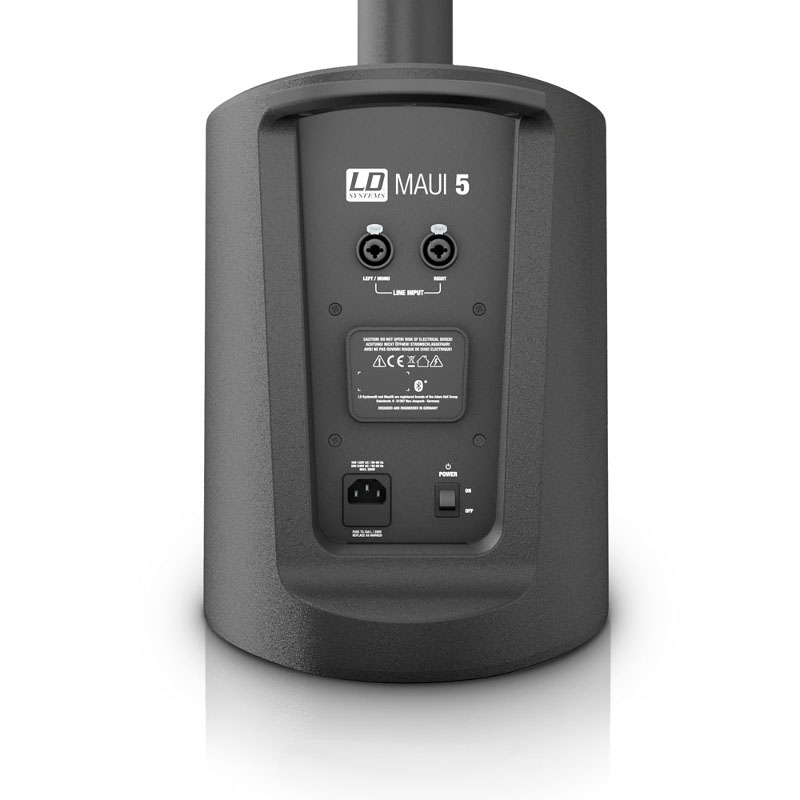
Finale
Looking at the retail price of EUR 549 and what the active “MAUI 5” with its 200 watts RMS provides, you have to say that apart from the lack of phantom power it delivers on all other fronts. The system is very light and at a push will fit on to a car seat. Put it down, stick it together and start it up is the word with this one. Of course, the “MAUI 5” is not designed for the high-decibel mega-rave sound or oppressive deep bass sounds. But smaller event rooms of up to 200 square metres can provide great-quality sound for an acoustic duo or trio outfit.
Whether for presenting, live music or background music, and even as a PA for smaller parties, I can see this system doing the job well. From above, the “MAUI 5” satisfies my aesthetic taste well and, due to its elegant appearance on stage, makes the grade as an all-rounder for event fairs or presentations too.
Anyone not satisfied with its performance level should look at the other alternatives provided by this growing range of compact sound systems. For example, check out other members of the “MAUI” family—choice and flexibility are on offer in abundance here.
Talking to
Benjamin Lampert, Research & Development Manager: “With the MAUI 5 we wanted to move into a dimension in terms of look, function and price that would allow as many prospective customers to experience the advantages of column technology. Especially in terms of mobile applications—which normally consist of classic boxes, three-legged tripods and small mixers—we wanted to provide a serious alternative, and we are pleased that tools sees things the same way.”
Pros
+ Bluetooth
+ elegant design
+ weight
+ Hi input
+ treble
+ sound
+ compactness in disassembled state
+ MP3 input
+ rapid set-up
+ four-channel mixer with DSP
Cons
– no phantom power
– sound at close range for full line length
Facts
Manufacturer and sales: LDSystems/Adam Hall
Model: “MAUI 5” active compact sound
Max SPL (continuous): 114 dB
Max. SPL (peak): 120 dB
Frequency response: 50 to 20,000 Hz
Angle (h x v): 120° x 20° PA
Height: 1.985 m
Weight: 11.3 kg
Other features: 4-channel mixer, DSP-based signal processing, Bluetooth (no apt-X codec)
Woofer: 8-inch, ferrite magnet
Housing design: Bass reflex
Housing material: ABS plastic
Subwoofer dimensions: 305 x 405 x 395 mm (W x D x H)
Size mid-range speakers: 4 x 3-inch neodymium magnets
Impedance mid/hi system: 4 Ohms
Housing type Mid / Hi system: closed
Housing material Mid / Hi system: ABS plastic
Dimensions Mid / Hi system: 82 x 535 x 105 mm (W x D x H)
Amplifier: Class-D
Amplifier power system (RMS): 200 watts
Amplifier power system (peak): 800 watts
Protection circuits: Surge, short circuit, DSP-based multiband limiter, overheating
Cooling: Convection
controls: Mic level, BT pairing button, line level, BT level, main level, MP3/Hi-Z level, sub level
display elements: Signal, protect (protection circuitry is active), on, limit
Power supply: Switching power supply
Line inputs: 2 x stereo
Line input connections: XLR; 6.3mm jack
Mic input connectors: 1 x XLR; 6.3mm jack
MP3 inputs: 1 x 3.5 mm jack,
Hi-Z input ports: 1 x 6.3 mm jack
Word length AD/DA converters: 24-bit
Sampling frequency: 48 kHz
List price: EUR 599
Sales price: EUR 549
______________________________________
Source: tools4music magazine, 01/2016 Germany: http://www.tools4music.de/
Find out more here about LD Systems MAUI 5:
http://www.ld-systems.com/en/series/maui-series/maui-5-ultra-portable-column-pa-system-with-mixer/
Leave a Comment
You must be logged in to post a comment.











